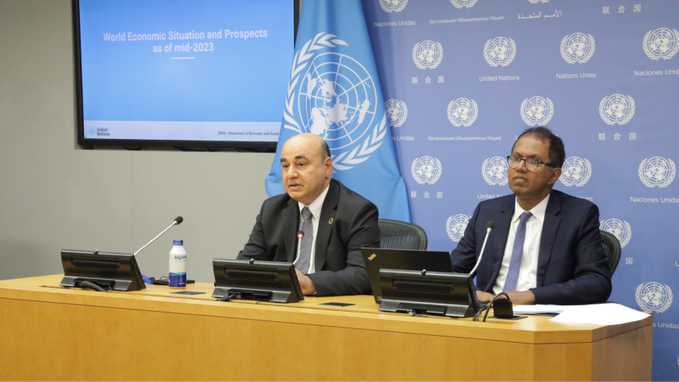
United Nations: The world economy faces the risk of a prolonged period of low growth amid lingering effects of the COVID-19 pandemic as also because the challenges of the ever-worsening impact of climate change, stubborn inflation, rising interest rates and heightened uncertainties remain unaddressed, according to the World Economic Situation and Prospects as of mid-2023.
The current global economic outlook also presents an immediate challenge to delivering on the Sustainable Development Goals (SDGs), said Li Junhua, UN Under-Secretary-General for the Department of Economic and Social Affairs (DESA).
“The global community must urgently address the growing shortages of funding faced by many developing countries, strengthening their capacities to make critical investments in sustainable development and helping them transform their economies to achieve inclusive and sustained long-term growth,” he said.
According to the report, the world economy is now projected to grow by 2.3 per cent in 2023 and 2.5 per cent in 2024, a slight uptick in the global growth forecast for 2023, according to the report, which is produced by DESA.
South Asia’s economy is projected to grow by 4.7 per cent in 2023 and 5.8 per cent in 2024, a slight downward revision of 0.1 percentage points for both years from the forecasts in January, the report said.
As the region is highly vulnerable to extreme climate conditions, potential droughts and floods also pose a significant risk to the economic outlook, it said.
India’s economy – the largest in the region – is expected to expand by 5.8 per cent in 2023 and 6.7 per cent in 2024 (calendar year basis), supported by resilient domestic demand. However, according to the report, higher interest rates and weaker external demand will continue to weigh on investment and exports in 2023.
Regional consumer price inflation is projected to average 11.0 per cent in 2023 and 9.4 per cent in 2024, slightly lower than the 12.9 per cent recorded in 2022. Inflation in India is expected to decelerate to 5.5 per cent in 2023 as global commodity prices moderate and slower currency depreciation reduces imported inflation.
Inflation rates in Pakistan and Sri Lanka are expected to remain in double digits in the coming months owing to weakening local currencies and supply-side constraints, the report said.
Domestic food inflation remains elevated due to country-specific factors, challenging food security across the region, particularly in Afghanistan, Bangladesh, and Pakistan.
Central banks in the region continued their interest rates hikes in early 2023 to tackle inflation and stabilize exchange rates, it added.
In the United States, resilient household spending has prompted upward revision of the growth forecast to 1.1 per cent in 2023.
Driven by lower gas prices and robust consumer spending, the European Union’s economy is now projected to grow by 0.9 per cent. As a result of COVID-19 related restrictions being lifted, China’s growth in 2023 is now forecast to be 5.3 per cent.
Despite this uptick, the growth rate is still well below the average growth rate in the two decades before the pandemic, of 3.1 per cent.
In Africa and Latin America and the Caribbean, gross domestic product (GDP) per capita is projected to increase only marginally this year, reinforcing a longer-term trend of stagnating economic performance.
The least developed countries are forecast to grow by 4.1 per cent in 2023 and 5.2 per cent in 2024, far below the seven per cent growth target set in the 2030 Agenda for Sustainable Development.
Global trade remains under pressure due to geopolitical tensions, weakening global demand and tighter monetary and fiscal policies. The volume of global trade in goods and services is forecast to grow by 2.3 per cent in 2023, well below the pre-pandemic trend.
Inflation remained stubbornly high in many countries even as international food and energy prices fell substantially in the past year. Average global inflation is projected at 5.2 per cent in 2023, down from a two decade high of 7.5 per cent in 2022.
While upward price pressures are expected to slowly ease, inflation in many countries will remain well above central banks’ targets. Amid local supply disruptions, high import costs and market imperfections, domestic food inflation is still elevated in most developing countries, disproportionately affecting the poor, especially women and children.
Rapid tightening of global financial conditions poses major risks for many developing countries and economies in transition. Rising interest rates, coupled with a shift in developed economies from quantitative easing to quantitative tightening, have exacerbated debt vulnerabilities and further constrained public spending options. APP
Please visit our website London Institute of Peace Research for latest peace news


